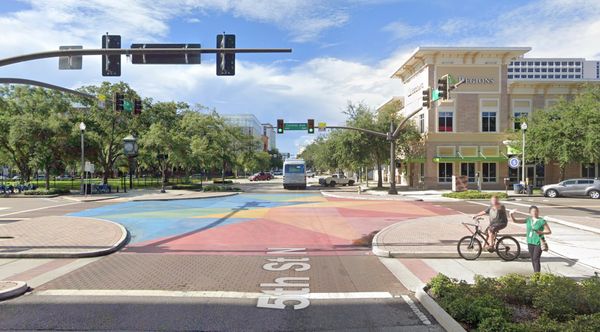This is Valley St & Oakview Ave, an intersection in the heart of Maplewood, New Jersey. Between December 2014 and June 2018, this intersection encountered a total of 17 traffic accidents.
Planners in this city asked a question frequently asked in the US: how can we make our streets safer for both pedestrians and drivers? And in June 2018, the city employed a novel approach to improving road safety: cosmetic changes.
Brush over the intersection with your cursor to reveal what the change was.
While the street certainly looks more lively, could it actually be distracting for drivers? How has the behavior of road users changed?
To answer that question, we can compare the number of crashes before and after the installation.
For Valley St & Oakview Ave, the total number of crashes before and after installation decreased from 17 over 3.3 years, to 9 over 2.6 years.
Put another way, the number of crashes per year decreased from 5.1 to 3.5, a relative change of -32%.
This intersection is one of many that has underwent cosmetic changes and seen improvements in road safety.
The multicolored murals and paint jobs at intersections like these are known as asphalt art, often implemented in place of, or in addition to, traditional roadway improvements such as islands or curb extensions.
Here are some examples—these intersections were the subject of a recent study by Sam Schwartz Consulting commissioned by Bloomberg Philanthropies.
Valley St & Oakview Ave is just one of the 17 intersections studied.
Each intersection is represented by a paint splotch
Researchers sought to understand how asphalt art improved the safety of these intersections, by analyzing crash rates before and after art installation.
In total, 14 out of 17 sites experienced a decrease in crashes per year. Considering all sites, there was an average decrease of 17%.
Despite the encouraging results, crash rates alone are not enough to demonstrate the effectiveness of any roadway intervention.
Crashes are considered rare and random events. They can be influenced by a host of extraneous factors, such as population growth or changes to transit networks, resulting in a rise in vehicle or pedestrian volumes.
Hence, researchers also studied behavioral changes at painted intersections.
Researchers examined 48 hours worth of video footage per intersection, before and after art was installed. This analysis was performed at five intersections, each denoted by
For instance, here are the changes in behavior recorded after the art installation at W Marshall St & Brook Rd.
Here, each line's position represents how much that behavior decreased after art installation.
Here are all of the intersections studied, each represented by a line
Examining each site individually, unfavorable behaviors did decrease across the board, albeit with a few exceptions.

Taking the average across all sites asphalt art resulted in significant improvements, including a 25% decrease in pedestrian crossings involving a conflict with drivers and a 27% decrease in pedestrians crossing outside of crosswalks.
The study provides encouraging empirical evidence about the effectiveness of such measures, especially in the face of regulatory hurdles in the US against art within the public roadway.
While it might be premature to imply direct causation, the data starts a conversation about innovative ways to improve street safety.
Perhaps safety doesn’t have to be rigid or dull and there is space for more novel and vibrant approaches to improve traffic safety.
Below, we'll leave you with the map from above. You can dive deeper into each site, seeing the intersection before and after art installation, and exploring how crash or behavioral data changed as a result. If you're interested in learning more, you can read Sam Schwartz' Asphalt Art Safety Study or visit Bloomberg's Asphalt Art Initiative site.
Use Ctrl + Scroll to zoom











































